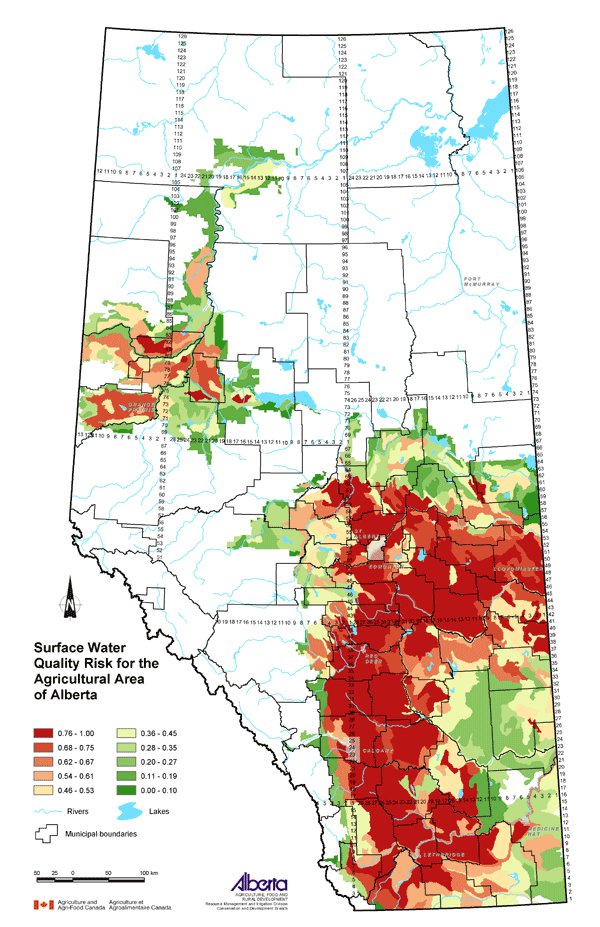| | Description | Data sources | Potential uses | Limitations | Further information | Download spatial information
Description
This map displays an assessment of surface water quality risk for the agricultural area of Alberta. Agricultural activities that may have an impact on surface water quality, including livestock, crop production and agrochemical use, were identified and used to produce this map. The classes shown on the map were ranked from 0 (lowest risk) to 1 (highest risk).
Data Sources
To assess surface water quality risk, physical characteristics and agricultural intensity were considered. Physical characteristics that make some surface waters more susceptible than others to contamination from agricultural activities are site-specific and therefore could not be addressed in this regional representation.
Soil Landscapes of Canada (SLC) Version 1.9 polygons were used to spatially represent the index values. SLC polygons were created using existing soil survey information. Each polygon is described by a standard set of soil and land attributes that characterizes the soil landscapes found in each SLC polygon. Soils, landscapes and climate are the key natural resource factors that determine agricultural productivity, and the farms within a soil landscape unit usually have similar production characteristics.
The components used in the Agricultural Intensity Index (AII) were derived from the 2001 Census of Agriculture data. Manure production was calculated from Census data collected about the numbers of all livestock raised in the province. Using research by Culley and Barnett (1984), Statistics Canada calculated the amount of manure produced by the total number of livestock. A formula that weighted the different livestock based on animal size and average manure output was used. The numbers of each type of livestock reported in the Census, multiplied by its manure factor, were totalled to give the total manure produced in tonnes.
Fertilizer use was determined from Census data collected on the amount spent on fertilizer and lime by producers. In the same way, agrochemical use was determined from Census data collected on the amount spent on farm chemicals (herbicides, insecticides and fungicides totalled together) by producers.
These agricultural inputs were used to derive the AII. The AII was developed through the Alberta Environmentally Sustainable Agriculture (AESA) Water Quality Monitoring Program and work done by Johnson and Kirtz (1998) and by Anderson, Cooke and MacAlpine (1999). The AII is the relative ranking of the sum of the rankings of watersheds by each of manure production, fertilizer use and agrochemical use, per unit area, based on 2001 Census of Agriculture data. For this process, agricultural inputs were integrated by SLC polygons, not watersheds. Calculation and custom processing of the Census data by Statistics Canada provided manure production (tonnes), fertilizer expense ($) and agrochemical expense ($) for each SLC polygon. These values divided by the SLC polygon area (square km) resulted in a ratio per unit area for each of manure, fertilizer and agrochemicals. These ratios were totalled to give the overall surface water quality risk factor, as displayed on the map.
Potential Uses
The AII was found to correlate well with measured water quality from monitoring sites on small streams and therefore is a good indicator of surface water quality risk. Each component of the Index is an important factor that illustrates agricultural intensity. Mapping livestock numbers is an indication of manure production and the potential risk of contamination by pathogens and nutrients. In the same way, mapping the use of fertilizers and agrochemicals is a proxy for crop production intensity and possible contamination of surface water through runoff and leaching of these inputs. In areas where these risk factors may affect surface water quality, environmental farm planning can help to mitigate them.
Limitations
The physical characteristics of a particular geographic area and the agricultural activities may contribute to surface water quality risk. This map represents the risk at a regional level. The site-specific physical characteristics are not applicable at this scale. Landowners can locate their own property on the map and identify the potential relative risks, but then must assess and evaluate their own conditions and determine the appropriate beneficial management practices (BMPs) based upon their site-specific knowledge.
Further Information
The AESA Water Quality Monitoring Program directs the numerous water quality monitoring activities taking place across the province. From the Alberta Agriculture and Food website, use the topic bar on the left and follow: Soil/Water/Air, Water Quality and Stream Monitoring. www.agric.gov.ab.ca
Canadian Soil Information System (CanSIS) provides soils information and data including information about SLCs. From the CanSIS website under Data, click on Soil Landscapes on the left side topic bar. http://sis.agr.gc.ca/cansis
2001 Census of Agriculture website expands on the use of the data collected. www.statcan.ca/english/agcensus2001
Anderson, A., Cooke, S. and MacAlpine, N. 1999. Watershed Selection for the AESA Stream Water Quality Monitoring Program. Alberta Environmentally Sustainable Agriculture, AF.
Culley, J.B. and Barnett, G.M. 1984. Land Disposal of Manure in Province of Quebec. Canadian Journal of Soil Science. 64:75-86.
Johnson, I. and Kirtz, J. 1998. Agricultural Intensity in Alberta, 1996 and Changes Since 1991. Alberta Environmentally Sustainable Agriculture, AF.
Click on map for larger view

Download Spatial Information
Agricultural Land Resource Atlas of Alberta - Surface Water Quality Risk for the Agricultural Area of Alberta
|
|